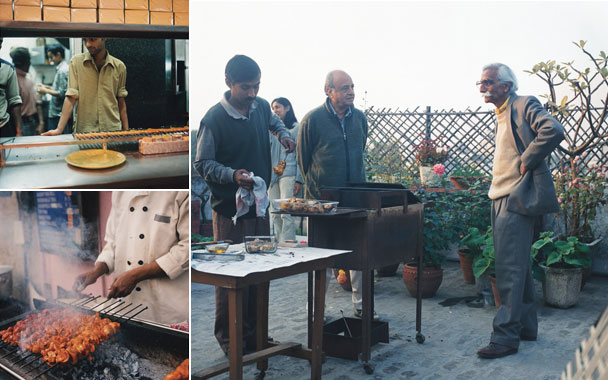In Delhi, in January 2006, I went to the Jama Masjid mosque, at the time of the Muslim festival of Eid-uz-Zuha. The minarets were lit a wizard green, the marble domes glowed unearthly in the night. Women in black burkas sped by, feet patterned orange with henna. Elegant bathed bearded men in starched white, looking as if they came from another age of grandeur, accompanied elegant bathed bearded goats in rickshaws, driving their animals to slaughter. For this is the festival that celebrates both the day the Koran was completed and the triumph of Ibrahim’s faith—the occasion when he offered his son as a sacrifice to God and found a ram to slaughter in place of the boy. Goats lose their lives out of proportion on this day. And people eat—monumentally, inordinately, passionately. On this day, indulging in food is an act of faith.
Pilgrims filled restaurants and stalls that looked chaotic but were anchored by the glowering eyes and staunch personalities of the owners, the perfect aesthetic harmony of their sitting with wide-girthed ease amid wide-girthed pots. Life moves quickly here, and you cannot linger in the communal crossroads of a thousand narratives racing past, disappearing into crooked side streets, into hidden -courtyards—you’re propelled into your own story.
I turned into the lane that goes to Karim’s. The Mughlai food of Delhi is famous around the mosque, and the family that runs Karim’s traces its lineage to the arrival in India of the first Mughal emperor, Babur. The pride in food here is of the kind that knows it needs no frills. The tables are plain, the room is plain, the food is cooked in the courtyard. But, whirling wonderful life—the rotis fly through the air as in a juggling act. The waiters run by in fast-forward. One has the feeling of a great river, of the momentum of thousands of meals served to hundreds of thousands over the ages. “By the grace of Allah,” says the menu, and “Good food makes good mood.”
The food is the burra kebab of marinated meat cooked in a tandoor; the seekh kebab of minced meat on a skewer; the sheermal roti, slightly sweet and flavored with saffron; meat curries of paya (feet) and brains—the kind of food that makes men men. Yet the fragrance is of the sweeter spices: mace, nutmeg, allspice, cinnamon, fennel, cloves, and cardamom, as well as rose water and kewra, screw pine essence.
Central to the Mughal cuisine of India is the kebab. The burra here scandalizes the taste buds with the contrast between an uncivilized heft of meat and bone, and the utter civility of flesh that is so tender it causes a small star of embarrassment in the back of one’s mind as one leaps to gnaw quick-quicker, so that this kebab can only be considered in retrospect.
Most of the Islamic Old Delhi of my parents’ generation departed for Pakistan in 1947—12 million were exiled. Overnight, a particular Delhi society, honed to fineness over the centuries, to a mingling of Hindu and Muslim, was gone. It was a society that prided itself on courtly refinement, on a sensitive and precious language, on manners as an art form, on a perfumed and extravagant cuisine. The old havelis, ornate homes carved to fretworks of lace and shadow, were left to decay; the patrons of the arts left; the courtesans and their songs departed. Between my parents’ youth and my own, Delhi was flooded with Hindu and Sikh refugees who built a society that turned its back on the past, for the only option in those days was to grasp at the future with everything you had.
I grew up in this unromantic, austere city, in a time of a curbed kebab. At home we made a lovely yet homespun shammi of minced mutton and lentils cooked and ground together with cloves and nutmeg, browned on a flat griddle over the stove. Sometimes we went to our neighborhood market of Defence Colony for other simple incarnations of the kebab, seekh and little chunks of boti kebab, skewered and grilled. Life moved slowly, anchored to family. It seemed as if nothing would change, and then, in the 1990s, India opened its doors to the free market, and it all came tumbling in: computers and cellphones, restaurants named Diva and Ploof, French brandy snifters, American tourists, obesity and anorexia, London town houses being constructed in the desert dust, restaurant guides unveiled in five-star hotels by Bollywood beauties in see-through saris.
Rising high on the mood of excess—buoyed by the appetite of a middle class gobbling up everything it had been kept from in earlier days, when ancient barriers of class and caste kept food hostage within communities—is the kebab.
Each week ardent journalists anoint new Kings of Kebabs, and like a secular version of a Hindu deity, the kebab is sprouting a thousand heads. There are famous hole-in-the-wall places, each showcasing reviews from the Sunday papers, each with pictures of celebrity patrons, each regarding the others with jealousy, hurt, and unbending pride: “We never speak to them!” said the men at Khan Chacha of Salim Kebab Corner, the shop at the other end of the same lane.
“What did you eat there?” Salim asked me.
“The mutton seekh.”
“Put a seekh on the grill,” he ordered his cook.
“No, I’ll try the fish kebab.”
“No, you’ll eat the mutton.”
He watched me carefully as I ate the kebab, hot and salty, flecked with coriander, ground with garlic and ginger, covered in mint chutney—the most vibrant thing in the muffled night.
“Once people eat here,” he said, “they’ll never go back to Khan Chacha!”



 Pinterest
Pinterest






